Are you a Quiet Speculation member?
If not, now is a perfect time to join up! Our powerful tools, breaking-news analysis, and exclusive Discord channel will make sure you stay up to date and ahead of the curve.
This past weekend I traveled to beautiful Vancouver to play Magic competitively at the highest professional stage. The format: Magic Origins Standard and Booster Draft. While not Modern, the Pro Tour is still the Pro Tour, and I figured a report from the perspective of a wide-eyed first timer would make for an interesting read. The level of excitement and hype leading into the event was incredible; as the final event of the 2014-2015 Professional Season many players were giving their all in their final chance to achieve individual Pro Players Club goals and secure their respective positions as Player of the Year, Rookie of the Year, and country representative spots for the World Magic Cup. As this was my first ever Pro Tour, my dreams were just as high, but my goals were a little more modest: make Day 2, don’t embarrass myself, try not to get DQ’d. This is my tournament report.
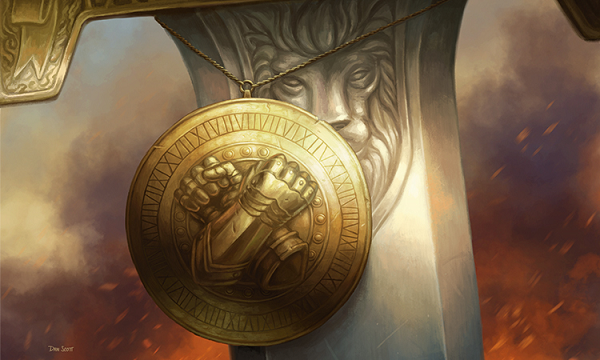
Preparation for Pro Tour Magic Origins began for me as soon as I qualified through my Regional PTQ win in April. My familiarity with the format at that time was spotty at best, as my attention towards Magic spiked during Theros and Khans of Tarkir releases but dropped off considerably during BNG/JOU and Fate Reforged. This meant that I was familiar with most of the top decks, but didn’t have a lot of experience regarding the various brews and what did/didn’t work or what had previously been tried/unexplored territory. This in mind, I embarked on my own personal Magic crash course; streaming my blunders with the world, who laughed along as I experienced for the first time decks like Heroic and Reanimator Whip strategies that had been around for weeks and months. This was very successful, as the resulting hilarity helped me grow my stream and reach Partnership while also letting me form the groundwork for testing once Origins came out.
[wp_ad_camp_1]
During spoiler season we made up a few brews on stream, including *spoiler alert* a deck very similar to the U/R deck that was the talk of the Pro Tour. As I had no testing “team” I knew going in that my time would be limited. I attempted to overcome this disadvantage by making a schedule and sticking to it; I would start earlier, work harder, and think smarter than everyone else. My inexperience would not be my downfall, if I was to be bested, it would be because of a disparity in skill, not preparation or resources.
Thoughts about the Format
Once the full spoiler was released, we started settling in and looking at the format as a whole, seeing what might change, and what would stay the same. When I say we I refer to the viewers on my stream, twitch.tv/Architect_Gaming, as we brainstormed together and built decks and jammed games right up to the night before my flight. Testing, and just looking analytically at the cards and decks people were talking about led me to some broad conclusions:
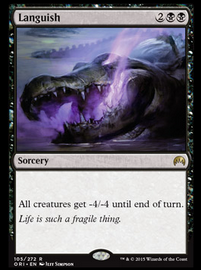 Languish, or possibly just the threat of Languish, looked like it would push Abzan Aggro right out of the metagame. Previously, the deck was able to take advantage of strong, resilient creatures at every spot of the curve that were both “must-answer” and “hard to kill”. Devotion strategies and Stormbreath Dragon made Ultimate Price one of the most appealing removal spells in the format, except for the fact that it is entirely dead against Abzan Aggro. Languish, as said by many, is a game-changer, as it invalidates all of the awkward positioning Abzan Aggro tries to create.
Languish, or possibly just the threat of Languish, looked like it would push Abzan Aggro right out of the metagame. Previously, the deck was able to take advantage of strong, resilient creatures at every spot of the curve that were both “must-answer” and “hard to kill”. Devotion strategies and Stormbreath Dragon made Ultimate Price one of the most appealing removal spells in the format, except for the fact that it is entirely dead against Abzan Aggro. Languish, as said by many, is a game-changer, as it invalidates all of the awkward positioning Abzan Aggro tries to create.
- The absence of Abzan Aggro could possibly lead to a resurgence in enchantments. Previously, the ability of one of the top decks in the format to play four Dromoka's Command helped keep red in check, while doing great work against individual cards like Outpost Siege and Jeskai Ascendancy.
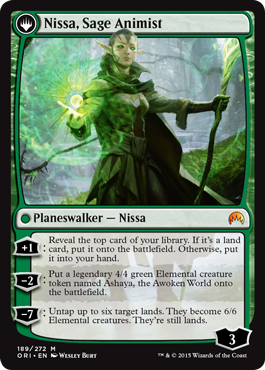 The flip-walkers all seemed relatively strong and looked like they would crop up in most decks.
The flip-walkers all seemed relatively strong and looked like they would crop up in most decks.
- Incorporating Nissa into Abzan, along with the exodus of 3/3’s and 4/4’s in the best aggro deck led me to believe that Wild Slash’s stock would rise greatly. I took this as a sign that I should move away from Goblin Rabblemaster as a result, so as not to get caught up in the Wild Slashes others would play, when I probably should have just sleeved up Wild Slash myself.
- The format looked like it would move decidedly more midrange, with Abzan gaining more consistency and power through Languish and Nissa, while Devotion gained a strong anti-control option in Gaea's Revenge.
The way I saw it, the Pro Tour metagame could move in two directions post Magic Origins release. With Abzan being the de-facto “deck to beat”, control decks like U/B and Sultai and midrange value decks like Constellation and Whip could rise up to fight Abzan, while looking to their sideboards to beat Aggro and Devotion. Or, the format could go hyper-aggressive, possibly with a return to Atarka Red and dash decks that attempt to fight Languish and Drown in Sorrow. While I knew that there were great examples of Pros picking up strong linear decks and crushing in the past (Tempered Steel at Worlds 2011, Bant Auras at Grand Prix Atlantic City 2013) I expected most teams to stick to the top decks with some small positional changes rather than try and attack the field with something new.
Testing Decks
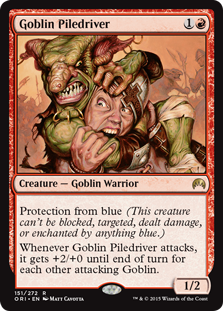 First, I built Goblins, because Goblins. The deck looked strong, synergistic, and powerful, and seemed like it would be able to capitalize on tapped lands and awkward three mana removal better than any other deck in the field. In addition, the strategy seemed surprisingly resilient to Wild Slash, as Foundry Street Denizen/Goblin Piledriver/Goblin Rabblemaster are each must-answer threats that demand cheap removal, while Dragon Fodder and Hordeling Outburst work to attack from a different direction. In addition, Frenzied Goblin/Goblin Heelcutter and Obelisk of Urd both seemed strong against opponents interested in interacting inside combat, and the deck still had great sideboard options in Roast and Searing Blood.
First, I built Goblins, because Goblins. The deck looked strong, synergistic, and powerful, and seemed like it would be able to capitalize on tapped lands and awkward three mana removal better than any other deck in the field. In addition, the strategy seemed surprisingly resilient to Wild Slash, as Foundry Street Denizen/Goblin Piledriver/Goblin Rabblemaster are each must-answer threats that demand cheap removal, while Dragon Fodder and Hordeling Outburst work to attack from a different direction. In addition, Frenzied Goblin/Goblin Heelcutter and Obelisk of Urd both seemed strong against opponents interested in interacting inside combat, and the deck still had great sideboard options in Roast and Searing Blood.
Unfortunately, the deck died to Drown in Sorrow. So bad. It had draws where it could drop an Obelisk on Turn 3, on the play, but even then it still died to Languish. Other decks like Atarka Red at least had access to strong burn spells and burst damage capabilities; Goblins was just too one-dimensional and easily disrupted.
From Goblins I moved on to U/R artifacts. Origins was kind to the archetype, granting the strategy tons of options all the way up the curve. Most people were talking about a midrange value strategy that looked to work its way up to Scuttling Doom Engine, but I was focused in keeping the curve low. Before Origins, Standard options for U/R included Ensoul Artifact, Shrapnel Blast, Springleaf Drum, Ornithopter, and Ghostfire Blade, all of which seemed to push the deck towards a faster identity. Doom Engine was just not something I was interested in when I had relative blanks like Ornithopter and Shrapnel Blast in my deck (deal 5’s are worse when trying to kill our opponent from 20). Before I abandoned the deck, this is where I was at:
UR Artifacts, by Trevor Holmes
My experiences with and against the deck pre-Origins taught me an important lesson: there is an incredible difference between the games where we draw Ensoul Artifact and the games we don’t. I wasn’t sure it would work, but I wanted to try Day's Undoing in a 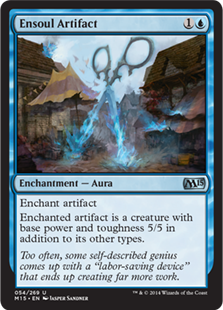 hyper-aggressive, synergistic deck that could take the most advantage out of the draw 7. Bonded Construct seemed like a strict upgrade to Keeper of the Lens, and Chief Engineer could help us dump our hand, using our 0 and 1 drop creatures to convoke out our bigger spells. With Day's Undoing and Chief of the Foundry as the top of our curve, we could play a super low land count alongside Springleaf Drum, and use Day's Undoing to refill while searching for our 10’s at the same time (Shrapnel Blast/Ensoul Artifact). I tested a few different options in the four slot, including Pia and Kiran Nalaar, Thopter Spy Network, Bident of Thassa, and Hangarback Walker (a functioning four, even though it does just as well as a two). Spy Network was definitely strong but played better in the grindy artifact decks like Jeff Hoogland’s U/W Thopter Control, while Bident of Thassa was an artifact and could be convoked out with Chief Engineer.
hyper-aggressive, synergistic deck that could take the most advantage out of the draw 7. Bonded Construct seemed like a strict upgrade to Keeper of the Lens, and Chief Engineer could help us dump our hand, using our 0 and 1 drop creatures to convoke out our bigger spells. With Day's Undoing and Chief of the Foundry as the top of our curve, we could play a super low land count alongside Springleaf Drum, and use Day's Undoing to refill while searching for our 10’s at the same time (Shrapnel Blast/Ensoul Artifact). I tested a few different options in the four slot, including Pia and Kiran Nalaar, Thopter Spy Network, Bident of Thassa, and Hangarback Walker (a functioning four, even though it does just as well as a two). Spy Network was definitely strong but played better in the grindy artifact decks like Jeff Hoogland’s U/W Thopter Control, while Bident of Thassa was an artifact and could be convoked out with Chief Engineer.
The deck seemed incredibly strong and was performing very well against the stock lists. It had some issues (due primarily to deckbuilding, as I was obviously the only one putting work in on the list) and I knew I had something, but I unfortunately just ran out of time and knew I couldn’t get the deck where it needed to be to make it through 10 rounds of Standard.
Picking a Deck
With the SCG Chicago and Richmond results, I had a new contender to worry about: Abzan Rally. The deck seemed incredibly powerful and hard to disrupt, as they can attack from multiple angles (combo, aggro, and value). It was giving Abzan Control fits, and I knew it would do well against blue control as well (I clearly remember being brutalized by Zach Jesse with Abzan Rally at the RPTQ’s when I was piloting Esper Control, my only loss in the event). It even seemed strong against aggro, as Satyr Wayfinder/Arashin Cleric/Deathmist Raptor value can be hard to fight through, especially with Rally bringing everything back.
With only a week left to prepare, I decided to just pick a deck and get experienced with the matchups. For better or worse, I chose Abzan Control.
Abzan Control, by Trevor Holmes, PT Magic Origins July 2015, 166th place
Hilariously, my maindeck ended up being just a few cards off from what Matt Sperling played to a Top 4 finish. I wanted Satyr Wayfinders to let me play a lower land count, make my 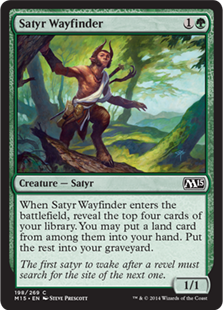 Tasigurs and Den Protectors better, and let me play a Murderous Cut as well (which is excellent to get back off a Protector flip), but I didn’t want to play Deathmist Raptor. Call it personal preference, call it play style, I just felt like my list would be better with access to more room for stronger bullets, and I knew I wouldn’t be able to fit Nissa, Vastwood Seer in (which was a perfect 10, btw) with so many other threes. I expected most of the field to go midrange, so I hedged by playing an Ajani, Mentor of Heroes maindeck (which seemed to be universally maligned, but I love) and a second copy of Ugin, the Spirit Dragon in the sideboard. I packed some hate for Rally, some anti-control cards, and some stuff for Mono-Red and got to work preparing for Limited. I’m not sure if anyone is interested in a detailed breakdown of my exact list, but if so, let me know in the comments or hop by my stream and I’ll gladly answer any questions.
Tasigurs and Den Protectors better, and let me play a Murderous Cut as well (which is excellent to get back off a Protector flip), but I didn’t want to play Deathmist Raptor. Call it personal preference, call it play style, I just felt like my list would be better with access to more room for stronger bullets, and I knew I wouldn’t be able to fit Nissa, Vastwood Seer in (which was a perfect 10, btw) with so many other threes. I expected most of the field to go midrange, so I hedged by playing an Ajani, Mentor of Heroes maindeck (which seemed to be universally maligned, but I love) and a second copy of Ugin, the Spirit Dragon in the sideboard. I packed some hate for Rally, some anti-control cards, and some stuff for Mono-Red and got to work preparing for Limited. I’m not sure if anyone is interested in a detailed breakdown of my exact list, but if so, let me know in the comments or hop by my stream and I’ll gladly answer any questions.
Magic Origins Draft
Blue sits in this weird position where it contains far and away the best C/U in Whirler Rogue, but beyond that the color just stinks. Artificer's Epiphany is strictly worse than Read the Bones, Claustrophobia is worse than Reave Soul, on and on. Black, green, and red seemed especially strong (in that order) and I knew I wanted to be either B/R or B/G in draft. I’m not joking when I say that two drops are the single most important thing in this format, and prioritizing two drops over stronger, more expensive options is something I continuously struggle with in Draft. Beyond that, I was able to get about 12-15 drafts in; nowhere near enough, but at least enough to get me familiar with the format and able to spot signals.
The Pro Tour!
I sat down to my first draft pod with Lucas Siow on my left and Brian Braun-Duin on my right. Welcome to the big time! My first pack was relatively weak, with Gideon's Phalanx as the 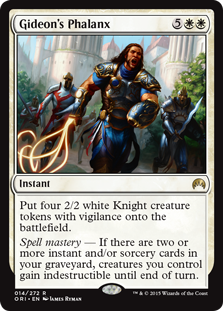 rare and Unholy Hunger as the only other option in the pack. While black is the color I wanted to be in, Unholy Hunger is not the best removal spell, and I’d definitely be much happier first picking a Reave Soul, Fleshbag Marauder, or maybe even a Nantuko Husk. I ended up taking the Phalanx, which in my experience has been fine but not great, and ended up with a sweet U/W deck with 3 Celestial Flare, 2 Suppression Bonds, 2 Claustrophobia, a Disperse and even a Thunderclap Wyvern. Lots of power, but my curve was very bad with almost no two drops. This would come back to bite me, as I consistently died to my opponent just drawing things and eventually outdrawing my removal while I was unable to apply pressure. I 1-2’d the pod, and definitely could have 2-1’d with a little better luck. Time for Standard!
rare and Unholy Hunger as the only other option in the pack. While black is the color I wanted to be in, Unholy Hunger is not the best removal spell, and I’d definitely be much happier first picking a Reave Soul, Fleshbag Marauder, or maybe even a Nantuko Husk. I ended up taking the Phalanx, which in my experience has been fine but not great, and ended up with a sweet U/W deck with 3 Celestial Flare, 2 Suppression Bonds, 2 Claustrophobia, a Disperse and even a Thunderclap Wyvern. Lots of power, but my curve was very bad with almost no two drops. This would come back to bite me, as I consistently died to my opponent just drawing things and eventually outdrawing my removal while I was unable to apply pressure. I 1-2’d the pod, and definitely could have 2-1’d with a little better luck. Time for Standard!
Day 1 Standard
I took two quick losses to David Kaplan playing Abzan Rally and Kazuya Murakami playing U/B Control 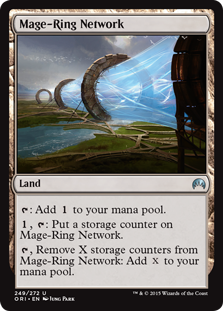 splashing Garruk, Apex Predator. His deck was sweet, featuring Mage-Ring Network as a four-of (I believe, as he had it turn two every game) to charge up and drop a Garruk as early as turn five, even if he doesn’t find the Network until turn three. With some better draws I definitely could have beaten both decks, as my deck drew pretty subpar while my Abzan Rally opponent hit a Collected Company and two Rally the Ancestors in four cards to fight through my Thoughtseize and Hallowed Moonlight. At 1-4, I had to Rally myself to make Day 2.
splashing Garruk, Apex Predator. His deck was sweet, featuring Mage-Ring Network as a four-of (I believe, as he had it turn two every game) to charge up and drop a Garruk as early as turn five, even if he doesn’t find the Network until turn three. With some better draws I definitely could have beaten both decks, as my deck drew pretty subpar while my Abzan Rally opponent hit a Collected Company and two Rally the Ancestors in four cards to fight through my Thoughtseize and Hallowed Moonlight. At 1-4, I had to Rally myself to make Day 2.
What followed was a string of three wins against two mirrors and a G/W Elf Company deck splashing Shaman of the Pack. My win and in was a super tight match against David Jetha, where I won on turn four of time when we only had eight minutes to play the third game. Major props to him for playing quickly and helping both of us avoid a draw.
Day 2 Draft
My Day 2 Draft was another star studded affair, as I sat to the right of Gold level Rookie of the Year Raymond Perez Jr. and two Platinum Pros in Josh McClain and Martin Juza. I’m not sure, but I believe I p1p1’d a Fleshbag Marauder, followed by multiple other strong black cards in Unholy Hunger and Reave Soul, until jumping into red which were both wide open. I had a feeling the player to my right was red, as I passed some strong red cards like Fiery Impulse and Subterranean Scout early, but a super late Act of Treason assured me I was definitely in the right colors. I was looking very solid going into Pack 3, with a good curve (though relatively two drop light), lots of removal (including three Unholy Hungers) and two Fleshbag Marauders. P3P1 I opened a Whirler Rogue, but unfortunately had to pass it on, I was then passed three Abbot of Keral Keep in a row. 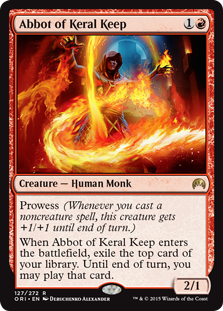 Having not played with Abbot in Limited before, I wasn’t sure of its ranking, and I’m pretty sure I punted by passing them on. My reasoning was that at the time I was pretty top-heavy for a B/R deck (with the 3 Hungers, Revenant, Enthralling Victor, and Prickleboar) but I ended up with just two drops (Dragon Fodder and Subterranean Scout) and really regretted not taking them.
Having not played with Abbot in Limited before, I wasn’t sure of its ranking, and I’m pretty sure I punted by passing them on. My reasoning was that at the time I was pretty top-heavy for a B/R deck (with the 3 Hungers, Revenant, Enthralling Victor, and Prickleboar) but I ended up with just two drops (Dragon Fodder and Subterranean Scout) and really regretted not taking them.
My deck was still solid, however, and I was able to easily win my first round against Andre Ramos Lima, who was sitting to my right, feeding me B/R, yet was still B/R himself! His deck was even more insane than mine, as he not only grabbed the three Abbot of Keral Keep but an Avaricious Dragon and Flameshadow Conjuring as well. In the second round of Draft I defeated Martin Juza in two games running G/W Renown. We both experienced some mana issues, but my removal let me power through both his defenses and his grumbling to take the match. To 3-0 the pod I had to face Juan Carlos Diaz with U/G, but my deck fell apart a bit and I couldn’t keep up with his draws. I was almost able to double Act of Treason his renowned Outland Colossus and second creature to hit him for exactsies, but he had the Turn to Frog. This ended a strong 5 match winning streak and put me at 6-5 going into Round 12.
Day 2 Standard
A win against David Heineman playing Mono Red put me to 7-5, within range of Top 75 and $1,000 cash if I could 3-1. His Mono Red deck was excellent, the Team version I believe, with lots of burn spells and maindeck Searing Blood. I was hopelessly outmatched, and couldn’t blank his Bloods if I tried as I was on Satyr Wayfinder, so I had to leave Nissa, Vastwood Seer and other subpar options in my deck. Courser of Kruphix and Siege Rhino still exist, however, and I was able to take the match.
Round 13 had me against Silver Level Pro Euguene Hwang from the US. A very strong player piloting the team U/R deck, we played an incredibly tight match that had him winning Game 1 off a topdecked Shrapnel Blast when he was dead the following turn, and a Game 3 when he killed me while he was at one life. This was the first time I had gone up against the U/R deck, and I’m glad I was able to quickly identify my role and my sideboarded Anafenza, the Foremost pulled their weight helping me race and keep Hangarback Walker in check. Unfortunately I fell just short and lost, putting me to 7-6.
 In Round 14, a wild Paul Cheon appeared, again playing the team deck in U/R Thopters. Paul was friendly enough, but spent most of the pre-match pleasantries complaining with another Pro about his horrible deck and bad luck. He promptly mulled to 4 on the play in Game 1 (justice) and then swiftly killed me with double Shrapnel Blast! We laughed about it, I told him I was placing a moratorium on complaining for the rest of the match, and we continued on. Game 2 he mulliganed again, and I was able to pick his hand apart with Thoughtseize and he fell apart after that. In Game 3 he mulliganed yet again (which he was complaining about, but mulligans are absolutely a common issue with the deck) and we fought a close one, leaving him dead to my next attack if he couldn’t peel Blast. In true #luckycheon fashion, he slowrolled his draw from the both of us for about two whole minutes, got incredibly excited when he saw a 1R red spell, but it turned out to be Roast, not Blast, and I took the match.
In Round 14, a wild Paul Cheon appeared, again playing the team deck in U/R Thopters. Paul was friendly enough, but spent most of the pre-match pleasantries complaining with another Pro about his horrible deck and bad luck. He promptly mulled to 4 on the play in Game 1 (justice) and then swiftly killed me with double Shrapnel Blast! We laughed about it, I told him I was placing a moratorium on complaining for the rest of the match, and we continued on. Game 2 he mulliganed again, and I was able to pick his hand apart with Thoughtseize and he fell apart after that. In Game 3 he mulliganed yet again (which he was complaining about, but mulligans are absolutely a common issue with the deck) and we fought a close one, leaving him dead to my next attack if he couldn’t peel Blast. In true #luckycheon fashion, he slowrolled his draw from the both of us for about two whole minutes, got incredibly excited when he saw a 1R red spell, but it turned out to be Roast, not Blast, and I took the match.
8-6 at this point and locked for Top 75 if I won out, I faced Maximiliano Sanchez and his foiled out R/G Aggro in Round 15. I had some clunky draws, his deck did its job, and I lost convincingly to Elvish Mystic/double Goblin Rabblemaster/Surrak, the Hunt Caller in three games. His deck was definitely built to beat up on all the G/R Devotion, Control, and Abzan strategies running around, but I couldn’t help but imagine how horrible his matchup was against the Red and U/R decks running around. With one round left, I resigned myself to fighting hard for 9-7 to keep me above even on the weekend.
Round 16 had me paired against Platinum Pro and Pro Tour Return to Ravnica winner Stanislav Cifka, piloting the team Red deck. His was slightly different, with Firedrinker Satyr’s maindeck, but he ran me over nonetheless and I died with a million three drops in hand, to finish 8-8 on the weekend.
Applications for Modern
The major players of the weekend were U/R Thopters and Mono Red. Better, more consistent versions of these decks already exist in Modern in the form of Burn and Affinity, but I think we can look at this Pro Tour as an example of what can happen when the metagame is pushed too far in one direction. The top teams correctly realized that decks were slowing down in an attempt to interact and one-up each other. By playing huge creatures to dodge Languish, and expensive three-mana Sultai Charms to hit Gaea's Revenge, the field opened up a weakness to Mono Red that would not have existed had the decks just stuck to their roles. For Modern, just keep in mind during event preparation the baseline, so as not to move too far away from it. I see Grixis Control decks getting more and more grindy in an attempt to beat the mirror, and I just keep coming back to how bad they can be destroyed by a solid Burn or Bogles list. Stay grounded!
Concluding Thoughts on the Pro Tour
While definitely not the result I was hoping for, I am immensely proud and satisfied with my performance on the weekend. While my results were decidedly average, I did rally back from a 1-4 start on Day 1 to finish all 16 rounds at Par on the highest stage possible of competitive Magic. My 3-3 draft record was unexciting but fine, and had I drafted slightly better in both drafts I know I could have 2-1’d the first pod and 3-0’d the second. My 5-5 record in Standard was exactly what I was expecting going in; I knew I would be playing Public Enemy number 1, with no great matchups and game against everything, and every round would be a fight. I played at the top of my game, can confidently say I made no punts (a small miracle, that) and had my share of complicated lines and good decisions. A few of my matches were extremely close and had a couple things gone a different way, a 10-6 or 11-5 record was definitely possible given my deck/matchups/gameplay. Without sounding like I’m excusing my average performance, I think that for my first Pro Tour, with no testing team and limited experience/testing time I did exceptionally well, and while I’m not qualified for Pro Tour Battle for Zendikar I can’t wait to get back on the big stage again to give it another shot.
 In the end, through this trip I learned a few things about Magic, the Pro Tour, myself, and life. The Pro Tour is an incredible stage, where the best players of the game gather to compete for fame and glory, but the reality of the grind is much different than what viewers see within the feature match area. I sat next to and played against many of my favorite Professional players, individuals whose articles I have read and decklists I have studied for years in an attempt to better myself at this game. While my outlook on the weekend was incredibly different to theirs (this being my first Pro Tour) I couldn’t help but notice how jaded many of these individuals who devote so much time to this game have become. There is a certain swagger among the top players in the Pro Players Club, a sense of entitlement that I’m sure can be attributed partially to us, the fans, and partially to themselves. I witnessed Wizards coverage and press shower these individuals with attention and praise, witnessed them muscle their way through crowds like they own the place, heard them joke about their Red Carpet registration line and compare it to flying first class vs. coach, all while avoiding our gazes like we are somehow beneath them. I experienced them belittle opponents (myself included) who beat them by complaining about poor draws, or how bad the “team deck” was, and then walk back to their group to update their scouting sheets with information on everyone else’s decks.
In the end, through this trip I learned a few things about Magic, the Pro Tour, myself, and life. The Pro Tour is an incredible stage, where the best players of the game gather to compete for fame and glory, but the reality of the grind is much different than what viewers see within the feature match area. I sat next to and played against many of my favorite Professional players, individuals whose articles I have read and decklists I have studied for years in an attempt to better myself at this game. While my outlook on the weekend was incredibly different to theirs (this being my first Pro Tour) I couldn’t help but notice how jaded many of these individuals who devote so much time to this game have become. There is a certain swagger among the top players in the Pro Players Club, a sense of entitlement that I’m sure can be attributed partially to us, the fans, and partially to themselves. I witnessed Wizards coverage and press shower these individuals with attention and praise, witnessed them muscle their way through crowds like they own the place, heard them joke about their Red Carpet registration line and compare it to flying first class vs. coach, all while avoiding our gazes like we are somehow beneath them. I experienced them belittle opponents (myself included) who beat them by complaining about poor draws, or how bad the “team deck” was, and then walk back to their group to update their scouting sheets with information on everyone else’s decks.
The ability of an individual to make it onto the big stage and succeed by themselves, through sheer grit, determination, and fortitude, is unfortunately impossible. All of my positive experiences at the event were with people slightly above me in terms of experience; those playing in their second or third Pro Tour, guys that tested with small groups of four or five. When asked who I tested with, all of them cringed when I told them I tested primarily alone. It was the company of the fellow grinder, not the gravy train Pro’s, that I found myself enjoying, and as the event progressed I became less and less excited every time I was paired against a “name”. The level of work required to keep up in a quickly changing format like Standard is incredible. Shaun McLaren was able to do it at Pro Tour Born of the Gods, but the format was Modern and he’s superhuman. My advice to anyone recently queued for a PT: “Find a team. Put in the work. Start two weeks before you think you should.”
On stream, I make a bunch of mistakes, and I always get occasional comments from new viewers like:
“This guy sucks.”
“How did he ever get on the PT?”
“PUNT.”
Normally I laugh them off, as they are responding to downright stupid plays I make that blow the game. Under the surface, however, they start to build, whether I notice it consciously or not, and sometimes I find myself questioning my abilities. 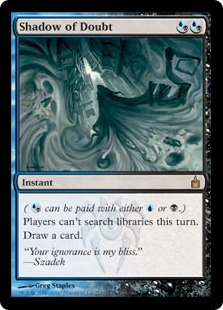 I’m not sure what my disconnect is between IRL Magic and Magic Online, but I have difficulty reading the interface. I get tunnel-vision and don’t pay attention to the board, the graveyard, life totals, time, whatever. Part of it is because I’m distracted by streaming, but I know that’s not entirely to blame because I make mistakes when playing alone too. The rare times I do get to play paper Magic really pick me up from a low place that I don’t even realize I’m falling into, where I wonder if I actually am good at this game, or did I just get lucky and win a soft RPTQ that got me to a stage where I don’t belong. It’s this low place that leads me to second guess opinions I have about decks/formats/card choices. If I was more confident in my opinions, and didn’t need to seek validation from Pro articles to confirm my findings, I would have jumped on Searing Blood sooner, started testing red more than two days before the PT, and recognized Jeskai Tokens for the trap that it was. I have a long way to go in every possible area of Magic, but I think what I need more than anything is confidence. Cashing my first PT would have got me there I think, but my 8-8 performance was definitely close. When I get back to the big stage, maybe then I’ll feel like I actually belong. Until then, my goal is clear.
I’m not sure what my disconnect is between IRL Magic and Magic Online, but I have difficulty reading the interface. I get tunnel-vision and don’t pay attention to the board, the graveyard, life totals, time, whatever. Part of it is because I’m distracted by streaming, but I know that’s not entirely to blame because I make mistakes when playing alone too. The rare times I do get to play paper Magic really pick me up from a low place that I don’t even realize I’m falling into, where I wonder if I actually am good at this game, or did I just get lucky and win a soft RPTQ that got me to a stage where I don’t belong. It’s this low place that leads me to second guess opinions I have about decks/formats/card choices. If I was more confident in my opinions, and didn’t need to seek validation from Pro articles to confirm my findings, I would have jumped on Searing Blood sooner, started testing red more than two days before the PT, and recognized Jeskai Tokens for the trap that it was. I have a long way to go in every possible area of Magic, but I think what I need more than anything is confidence. Cashing my first PT would have got me there I think, but my 8-8 performance was definitely close. When I get back to the big stage, maybe then I’ll feel like I actually belong. Until then, my goal is clear.
For those that haven’t seen it, Corbin Hosler did an incredible piece about me and my first Pro Tour experience here; it would mean a lot to me if you would check it out! As always, if you have any thoughts/opinions/questions, feel free to ask below. I didn’t dive much into my experiences in Vancouver, as my experiences outside the convention hall contain much less gourmet food and Platinum Pro name dropping and much more bus rides and homeless people. I did have a great time in Vancouver, however, and would definitely visit the city again. Just stay away from East Hastings St and the Patricia Hotel!
Thanks for reading,
Trevor Holmes
The_Architect on MTGO
Twitch.tv/Architect_Gaming
Twitter.com/7he4rchitect




Good stuff – thanks for sharing your experience. I started playing Magic with my dad as well, so Corbin Hosler’s article definitely resonated with me. As far as the egos in the PT and the heckling goes, block it out, man – I think there’s enough evidence to show you’re a darn good player (though I will give you a little grief for going over Abzan over UR Artifacts, lol), and you shouldn’t have to worry about what they think. Keep your eyes on the prize and go kick some tail.
Out of everything I learned, being brave and going with my gut was my biggest takeaway from the event. I will definitely be more confident in my thoughts and opinions in the future!
Such good insight on standard, makes me want to change things and add things to some of my decks.
Really interesting read into the prep and event of a PT. The work that goes into just prepping for this kind of event is crazy. Congrats on the 8-8, better than I would have done.
Thanks man!
Congrats on the 8/8 result! Considering that you didn’t have a team (though maybe those of us who watch your stream count in some way?) and that it was your first Pro Tour, I consider that a very respectable result.
I’m playing in my 3rd GP ever (London) very soon and although I’d like to make Day 2, I just don’t have the time to really practice/play enough at the moment due to my job getting in the way.
But one day, when things calm down a bit, I’d certainly like to see if I can start streaming on twitch in a similar way to you 🙂
Thanks for the stream – from thatbloke83
Thanks man! Testing on stream with viewers certainly helped, I owe a lot of my success to the individuals that stood by me and offered opinions while we were exploring the format. However, it is difficult to put forward consistent, focused work with drop in/drop out viewers, however helpful they may be. I enjoyed testing on stream, but it was definitely a different experience than testing with a focused group of players together.
Top notch article!
Great article and congrats on your PT showing!
Thanks!
Especially liked the bits about the jaded big name players and would like to see more on their occasional (or not?) petulance. It’s something I’ve observed myself at larger events like GPs, though granted I’ve never made a Pro Tour, and consider competitive Magic’s dirty little secret: how its most lauded players are big babies. In Charlotte, I had a conversation with [name drop]Josh Utter-Leyton[/name drop] about the pro circuit, and he categorically told me it was a “numbers game.” So, Trevor, if you want to make the Tour again, all you need to do is keep grinding! Nice piece and good luck.